Access to Work statistics: April 2007 to March 2023
Updated 28 September 2023
Applies to England, Scotland and Wales
Main stories
The key points from this release covering Access to Work in the financial year 2022 to 2023 are:
- Access to Work provision was approved for 49,820 people
- total expenditure on Access to Work was £182.9 million
- 47,230 people were in receipt of an Access to Work payment
What do these statistics show?
These statistics are about 2 specific parts of the Access to Work customer journey:
- approval of Access to Work provision
- payment of Access to Work provision
They show the number of people who had Access to Work provision approved, number of people who received at least one Access to Work payment and Access to Work expenditure. These are disaggregated by various breakdowns including:
- financial year
- type of provision
- primary medical condition
- region
- age
- gender
Information on gender and region can be found in the accompanying spreadsheet.
When interpreting results, particularly comparing time periods, users should be aware of the potential effect of the coronavirus (COVID-19) pandemic between 2020 and 2022.
The expenditure data in these statistics covers Department for Work and Pensions (DWP) expenditure only. In many cases, the employer will be asked to contribute to the cost of provision under “cost share” arrangements. The employer element of expenditure is not included in these statistics. This data is used to calculate statistics on the number of people in receipt of Access to Work payments in each year.
Access to Work continued to provide Communication Support for Interviews to individuals during 2020 to 2021. However, due to the Access to Work digital transformation programme and the move to a new administrative system, it is not possible to identify how many people had an approval or received a payment for Communication Support for Interviews in 2020 to 2021. Data is available for 2022 to 2023, which shows 180 people received a payment for Communication Support for Interviews.
What is Access to Work?
Access to Work is a publicly funded employment support programme that aims to help more disabled people start or stay in work. There are 2 main types of Access to Work provision:
- ‘Assessments’
- ‘Elements’
Assessments involve exploring workplace-related barriers to employment and making recommendations on how these can be overcome. In some but not all cases the outcome of an Assessment may be to recommend the provision of one or more Elements.
Elements are intended to supplement the reasonable adjustments that employers are required to make under the Equality Act 2010. The types of Element that can be provided are categorised as follows:
- Communication Support for Interviews
- Special Aids and Equipment
- Adaptations to Premises
- Adaptations to Vehicles
- Travel to Work (help with the costs of travelling to work)
- Travel in Work (help with the costs of work-related travel)
- Support Worker
- Mental Health Support Service
- Miscellaneous
In some but not all cases an Assessment is required to find out whether a customer is eligible to receive an Element.
Access to Work customer journey
The main stages of a typical Access to Work customer journey are summarised here.
-
Application: The customer applies for Access to Work provision.
-
Approval/Rejection: DWP approves or rejects the provision after considering the customer’s eligibility and their employer’s duty to make reasonable adjustments under the Equality Act 2010. The customer is notified of the decision and a grant may be approved to cover some or all of the costs of the approved provision.
-
Decision: When a decision is made the customer is notified of the grant and the level of funding. The funding may cover some or all of the costs of the support needs.
-
Commissioning: The customer or their employer commissions the approved provision and submits invoices relating to approved grants to DWP.
-
Receipt: The customer receives the approved and commissioned provision.
-
Payment: DWP pays the invoices relating to approved grants. In some cases a DWP payment is not required, for example because provision can be provided at no cost or the employer covers the relevant costs.
-
Review: During the award period DWP will complete reviews to ensure the grant and level of funding continues to meet the Customers support needs.
-
Renewal: At the end of their award period customers are invited to renew their claim if necessary.
Access to Work approvals in 2022 to 2023
Access to Work (AtW) provision was approved for 49,820 people.
Number of people who had any Access to Work provision of each type approved in 2022 to 2023

The key points are:
- of the 49,820 people who had an AtW provision approved in 2022 to 2023, 48,350 (97%) had an Element approved. This includes those who may also have had an Assessment approved. The remaining 3% had one or more Assessments approved in 2022 to 2023 without any Elements approved in the same period. This may be because they had one or more Elements approved in a subsequent period or they did not require an Element or were not eligible for one
- 18,290 (37%) of those who had an AtW provision approved in 2022 to 2023 had an Assessment approved. This includes those who may have also had one or more Elements approved
- the remaining 63% had an Element approved without an Assessment approved in the same period. This is mainly because the corresponding Assessment was approved in a preceding period for example if the Element is a series of ongoing payments as seen with Travel to Work.
- data relating to previous years can be found in the accompanying spreadsheet in Table 1.
Support Worker Elements were approved for more people than any other type of Element.
Number of people who had any Element of each type approved in 2022 to 2023

The key points are:
- the most common Element that was approved in 2022 to 2023 was the Support Worker Element. 50% of the 48,350 people who had any Element approved had one or more Support Worker Elements approved in the same period. This includes those who may have had more than one Element approved in the same period
- the next most frequently approved Element types were:
- Special Aids and Equipment (39%)
- Mental Health Support Service (22%)
- Travel to Work (20%).
- it should be noted that more than one Element of the same type or of different types can be approved for the same person in a given financial year
- it should also be noted that an approval for Access to Work does not necessarily result in a payment for Access to Work, a customer’s employer may pay for the support in full, or the customer may choose not to take up the support
- data relating to previous years can be found in the accompanying spreadsheet in Table 2
Access to Work expenditure over time
Total nominal expenditure on Access to Work was £182.9 million in 2022 to 2023.
Expenditure on Access to Work provision 2009 to 2023 in millions (Nominal terms)
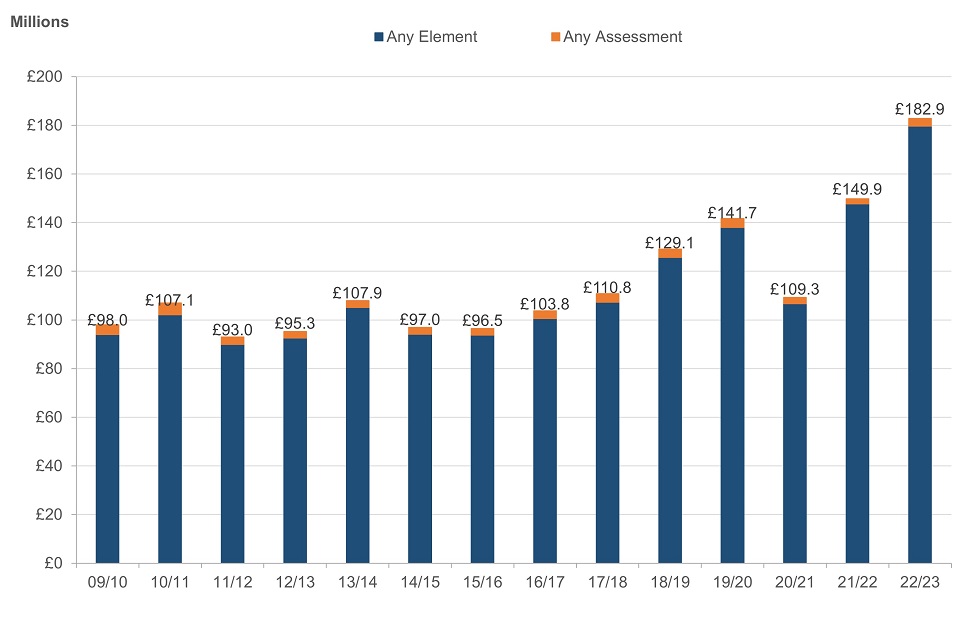
The key points are:
- total nominal expenditure on Access to Work provision increased to £182.9 million in 2022 to 2023
- £179.7 million of this was expenditure on Elements. The remaining £3.2 million was on Assessments. Assessments account for around 2% of total expenditure
- nominal expenditure is the amount reflected on financial balance sheets. It does not account for inflation; therefore, real terms expenditure should be used for year on year comparisons
- see Table 11 for full data, and Table 12 for expenditure on Elements of each type in the accompanying spreadsheet
Expenditure on Access to Work provision, 2009 to 2023 (Real terms)
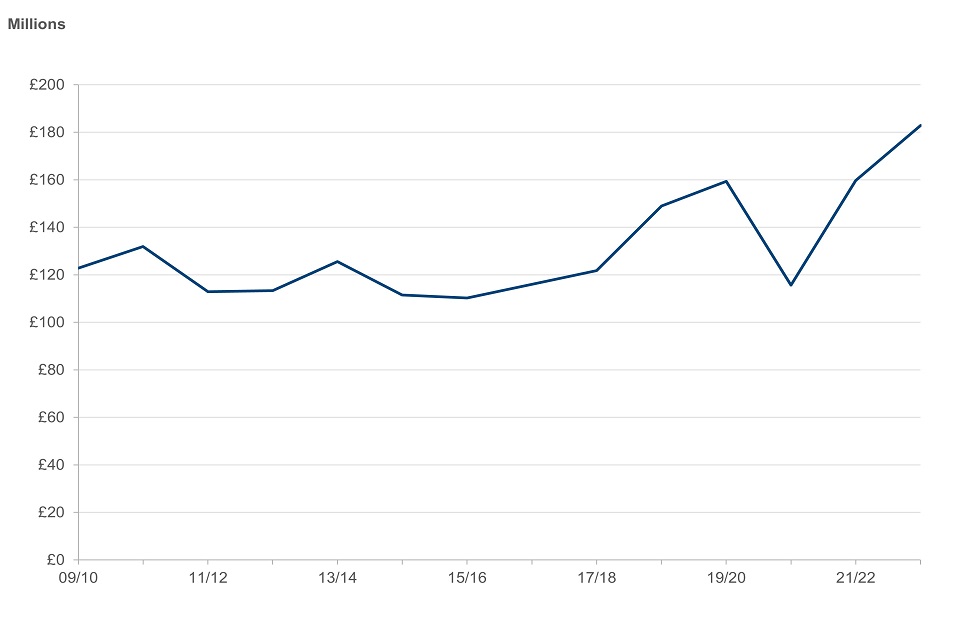
The key points are:
- real terms expenditure removes the effect of inflation to make year on year comparisons possible, using 2022 to 2023 as the base year.
- in 2022 to 2023, real total expenditure increased by 15% compared to the previous year and is now higher than pre-pandemic levels in 2019 to 2020. Expenditure changes differed for different elements, which is explained in sections below.
- see statistics on the number of people who received a payment by element type
- see Table 11a of the accompanying spreadsheet for more details
More information about expenditure
Expenditure data used comes from the Department for Work and Pensions’ Disability Service Client (DiSC) administrative system. This provides granularity (for example, expenditure broken down by provision type), but this data is reweighted to match the total Access to Work expenditure recorded through the department’s Single Operating Platform (SOP). SOP is the payment system used for much of the department’s business.
SOP provides a more reliable measure of spend than DiSC however the data cannot always be disaggregated to the same level of detail as that in DiSC. Please see the accompanying Background information and methodology note for more detail.
Number in receipt of payment of Access to Work over time
47,230 people were in receipt of Access to Work payments in 2022 to 2023.
Number of people who were in receipt of one or more payments for any Access to Work provision of each type, 2009 to 2023
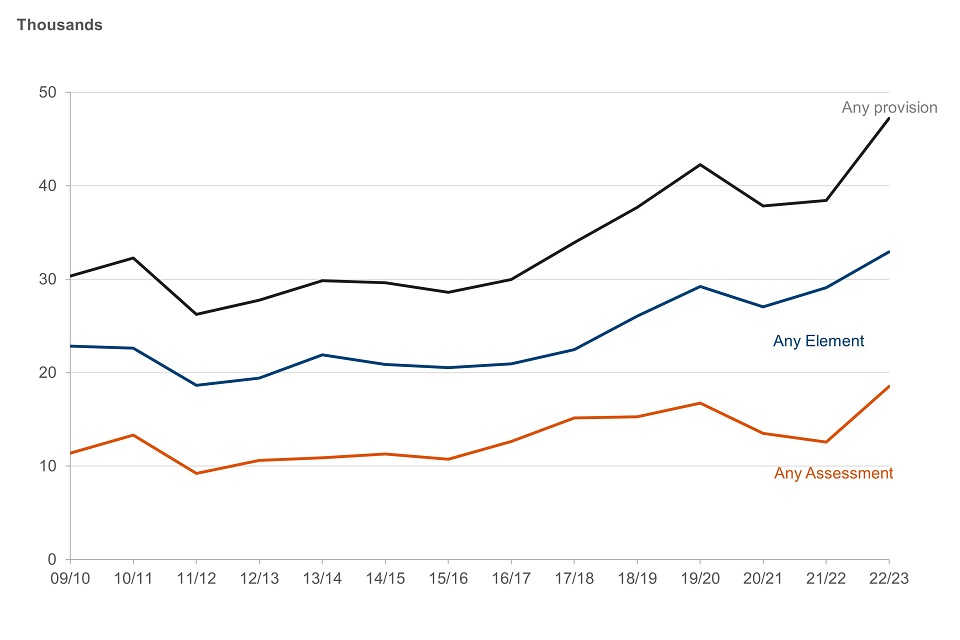
The key points are:
- when compared to the previous year, there was a 23% increase in the number of people who received a payment for Access to Work provision in 2022 to 2023
- the number of people who received a payment for an Assessment increased by 48% in 2022 to 2023 when compared to the previous year
- of the 47,320 people who received a payment for Access to Work provision in 2022 to 2023, 32,930 (70%) received the payment for one or more Elements. This includes those who may have also received payment for an Assessment. The remaining 30% received a payment for an Assessment only, without receiving a payment for any Elements in the same period. This may be because they received a payment for one or more Elements in a subsequent period or they did not require an Element or were not eligible for one
- of those who received a payment for Access to Work provision in 2022 to 2023, 18,530 (39%) received a payment for one or more Assessments. This includes those who may have also received payment for one or more Elements. The remaining 61% received a payment for an Element only, without receiving a payment for an Assessment. This may be where the customer received the assessment in a preceding period
- see Table 6 of the accompanying spreadsheet for full data
More people were in receipt of a payment for Support Workers than any other type of Element.
Number of people who received a payment for any Access to Work Element of each type, 2012 to 2023
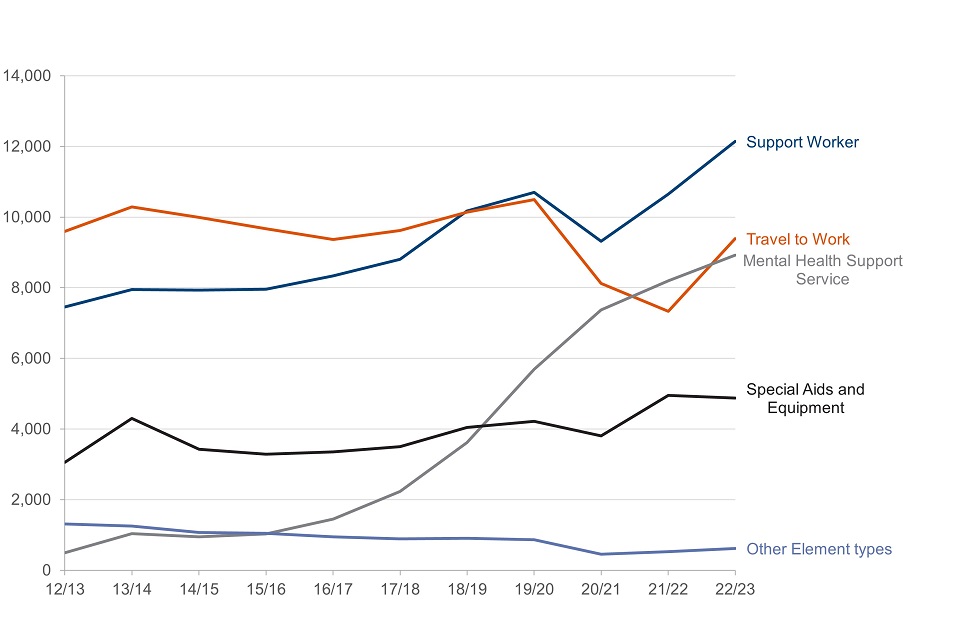
The key points are:
- the Support Worker Element continues to be the most common Element amongst people who received a payment, having increased by 14% in 2022 to 2023 compared with 2021 to 2022
- Travel to Work had the second highest number of people who received a payment, having increased by 28% in 2022 to 2023 compared with 2021 to 2022
- the number of people who received a payment for Mental Health Support Service has been rising since 2015 to 2016, increasing from 1,030 to 8,920 in 2022 to 2023, and is now the third most common element. In the last year, the number of people who received a payment for Mental Health Support Service rose by 9%
- see Table 7 of the accompanying spreadsheet for full data
Characteristics of Access to Work customers in 2022 to 2023
Percentage of total expenditure and percentage in receipt of payment in 2022 to 2023 by primary medical condition
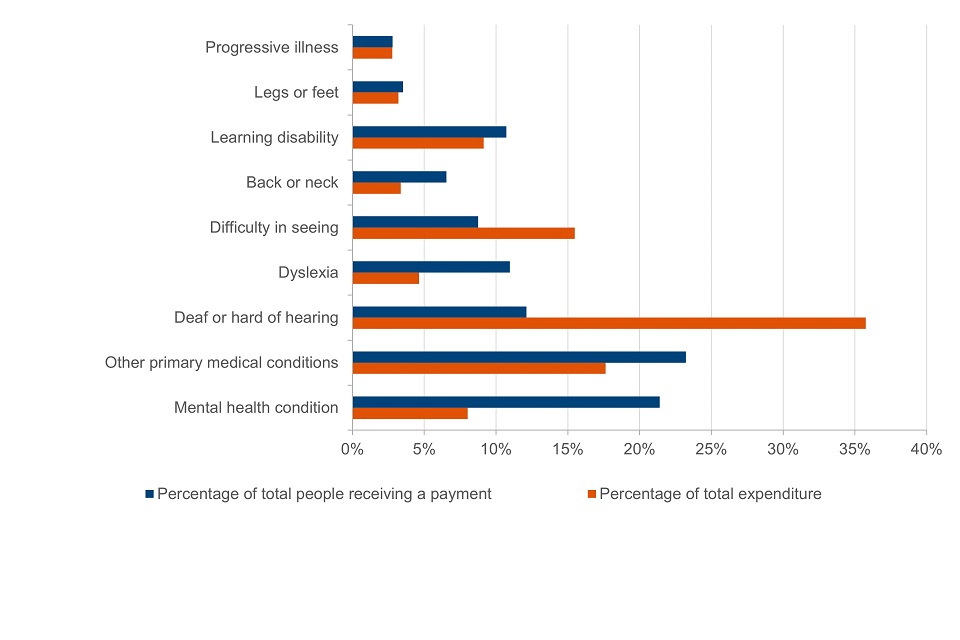
The key points are:
- the largest Access to Work customer group in terms of number of payments, by primary medical condition are those with a ‘Mental health condition’, who account for 21% (10,110) of the total number of customers. Those with the primary medical condition ‘Deaf or hard of hearing’ are the second most common group and make up 12% of customers (5,720 people)
- those who are ‘Deaf or hard of hearing’ are in receipt of the highest proportion (36%) of total Access to Work expenditure
- see Tables 8 and 13 of the accompanying spreadsheet for full data, including breakdowns by gender, age and region
Access to Work continues to support young people as well as those customers who are older.
Percentage of people in receipt of a payment in 2022 to 2023 in each age group
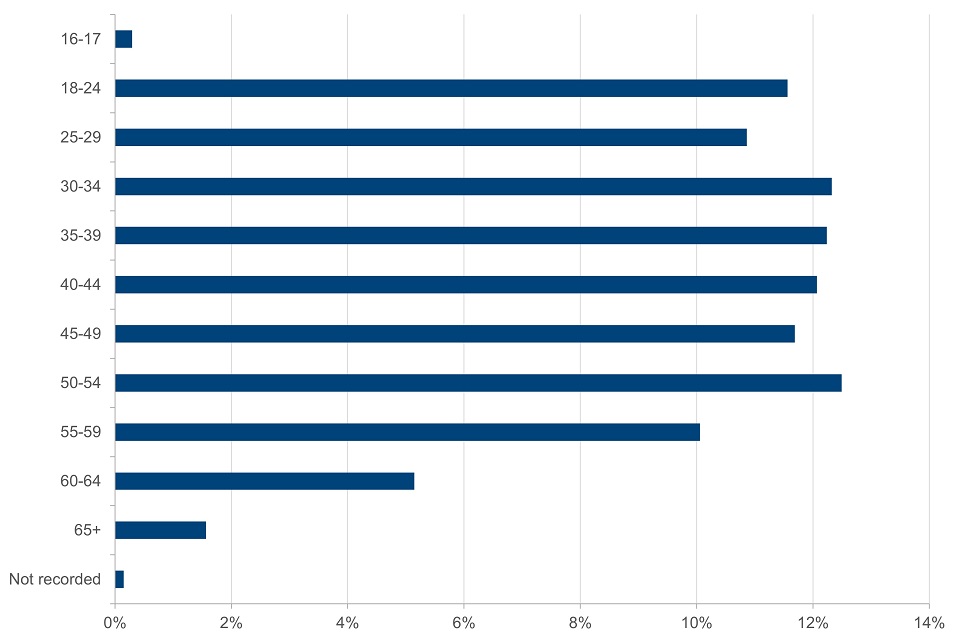
The key points are:
- the largest Access to Work customer group in terms of number of payments, by age are those aged 50 to 54 however the age distribution is mostly uniform across age bands 30 to 54
- people of all eligible ages are in receipt of Access to Work support
See Table 8 of the accompanying spreadsheet for full data, including breakdowns by primary medical condition, gender and region.
More information about these statistics
These statistics have been developed using guidelines set out by the UK Statistics Authority and are new official statistics undergoing development. They have therefore been designated as experimental statistics. It is planned for these statistics to be published on an annual basis and the feasibility of expanding their scope to cover other parts of the Access to Work customer journey, such as applications to Access to Work, will be explored. Users are invited to comment on the development and relevance of these statistics at this stage and can send feedback to: access.toworkstatistics@dwp.gov.uk
These statistics were obtained from DWP’s Disability Service Client (DiSC) administrative system. DiSC is a live system and figures may be revised in future publications as records are amended or added to the system. More information about DiSC and revisions to these statistics can be found in the accompanying Background information and methodology note.
Figures in this publication are rounded to the nearest 10 and nearest £1,000. Percentages are calculated using figures prior to rounding and are rounded to the nearest integer. Totals may not sum due to rounding or missing data.
Statement of compliance with the Code of Practice for Statistics
The Code of Practice for Statistics (the Code) is built around three main concepts, or pillars:
- Trustworthiness – is about having confidence in the people and organisations that publish statistics
- Quality – is about using data and methods that produce assured statistics
- Value – is about publishing statistics that support society’s needs for information
The following explains how the pillars of the Code have been applied in a proportionate way.
Trustworthiness
Access to Work Official Statistics have been produced in line with the Code.
Quality
The data sources used for new analysis in this release are already used for similar analyses in previous Access to Work publications. The specific analyses included here have been quality-assured, including through peer-review, plausibility checks and validation against other published sources.
Value
This release provides a detailed picture of Access to Work up to March 2023.
Making this information accessible provides Ministers and stakeholders with an overview of Access to Work, while helping to reduce the administrative burden of answering Parliamentary Questions, Freedom of Information requests and ad hoc queries.
Pre-release access
In addition to staff who are responsible for the production and quality assurance of the statistics, up to 24-hour pre-release access is provided to Ministers and other officials. Job titles and organisations of the people who have been granted up to 24-hour pre-release access to the latest Access to Work statistics is published.
Where to find out more
More information about these statistics can be found in the Background information and methodology note and the Data tables that accompany each release.
Read more information about Access to Work.
Guidance on Access to Work for employers.
More information about experimental statistics.
Contact details
For queries or feedback on this publication, please contact: access.toworkstatistics@dwp.gov.uk
For press queries, please contact DWP Press Office: 0203 267 5129
Authors: Jennifer Shannon and Ellie Grainger
ISBN: 978-1-76859-552-2
Next release
This publication is annual, and the next release will be published in August or September 2024.
